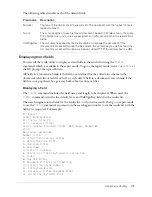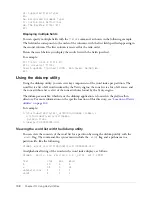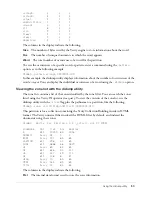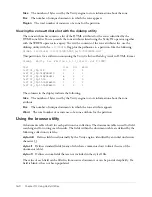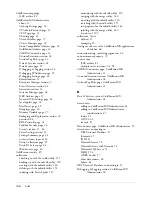
Using the mkvdk utility
151
Deleting a collection
To delete a collection, use the appropriate command for your operating system. For example, to
remove the collection directory structure and control files on a UNIX system, use the following
command:
rm -r -collection_path
Purging a collection
The following command deletes all documents from a collection, but does not delete the
collection itself:
mkvdk -purge -collection path
Purging a collection in the background
The following command purges the specified collection in the background:
mkvdk -purge -purgeback -collection path
Specifying persistent service
The following command runs the mkvdk command as a persistent process, so that servicing is
performed repeatedly after num idle seconds:
mkvdk -persist -sleeptime num -collection path
Deleting a collection
The
-purge
option deletes all documents in a collection, but does not delete the collection itself.
To delete a collection, use operating system commands, such as the rm command on UNIX, to
remove the collection directory structure and control files.
Optimization keywords
The following table describes the optimization keywords for the
-optimize
option:
Keyword
Description
maxclean
Performs the most comprehensive housekeeping possible, and removes out-of-date
collection files. Macromedia recommends this optimization only when you are
preparing an isolated collection for publication. When using this type, if the collection
is being searched, files sometimes get deleted too early, which can affect search
results.
maxmerge
Performs maximal merging on the partitions to create partitions that are as large as
possible. This creates partitions that can have up to 64000 documents in them.
readonly
Marks the collection as read-only and unchanged after the function call is done. This
is appropriate for CD-ROM collections.
spanword
Creates a spanning word list across all the collection’s partitions. A collection consists
of numerous smaller units, called partitions, each of which includes a word list.
Optionally, a spanning word list can be built with an ngram index.
Summary of Contents for COLFUSION MX 7 - INSTALLING AND USING COLDFUSION...
Page 1: ...COLDFUSION MX7 Configuring and Administering ColdFusion MX ...
Page 6: ...6 Contents ...
Page 10: ......
Page 78: ...78 Chapter 4 Web Server Management ...
Page 84: ...84 Chapter 5 Deploying ColdFusion Applications ...
Page 102: ...102 Chapter 7 Using Multiple Server Instances ...
Page 104: ......
Page 108: ...108 Chapter 8 Introducing Verity and Verity Tools ...





















